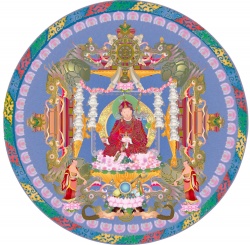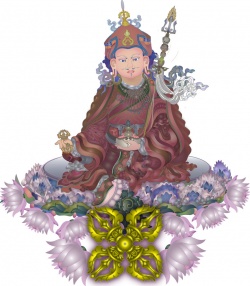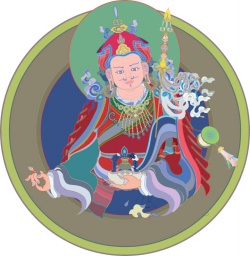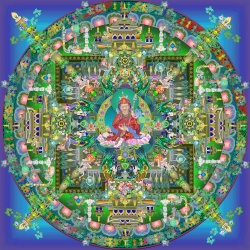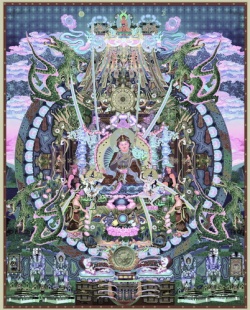A Western Approach to Tibetan Dark Retreat Meditation
Retreats in darkness have been used by all the great spiritual traditions for thousands of years as a method for tapping deep clarity, accessing sacred wisdom, connecting with the Divine, and training to transform the mind/body system into a manifestation of wisdom. In Tibetan Buddhism and Bon, the teachings and practices of dark retreat have been passed down through the ages and are taught and practiced today.
Darkness As a Setting
Dark retreats are both a setting for doing meditation practice and a specific practice environment for Dzogchen teachings in the Bön and Nyingma lineages of Tibet. In the dark, the seamless unity of space provides an environment for realizing the seamless unity of experience. The thoughts that arise are clearly the product of the differentiating conceptual mind and their transient, insubstantial nature is more apparent. The dark provides a profound opportunity to recognize our true nature and realize that our experiences are simply reflections of that nature. The resulting clarity can lead to the realization of profound wisdom, unshakable presence, spontaneous freedom from our mental/emotional habits, transformation of the ordinary into wisdom, and abiding in a state of Clear Light.
The dark is a kind of womb in which to grow into a new way of being. The particular advantages of the dark are many. The rest for our eyes, weary from overstimulation in our visually oriented world, promotes an overall relaxation of body and mind. Living in the dark changes the body chemistry, particularly the pineal, pituitary, thalamus, and hypothalamus glands. The less frequently used senses of hearing and touch expand in importance as we mindfully operate in ways adapted to functioning without the use of sight. The life is simple, allowing for more time and effort to be concentrated on practice. Without the stimulation of external light, the conditions are improved for seeing the inner lights, and it is easier to observe the thought patterns that arise out of the internal dynamics of our own minds. The visions and thoughts in the dark tell us what life is like in the unnoticed regions of our being. And the darkness is both intimate and boundless simultaneously.
Tibetan Bön Dzogchen and Dark Retreat
In the Bön tradition of Tibet, dark retreat is considered one of the most powerful and suitable environments for working with the teachings of Dzogchen, the practice of the nature of mind. Dzogchen works with the essence of all being and that which is beyond everything. It is often referred to as the direct path of liberation in which we are able to recognize the open nature of experience. We see each experience exactly as it is, without treating it as having power of its own or requiring any response.
Dzogchen is a view of reality that is based on a profound understanding of the nature of all being, awareness, and experience. This nature of all being, awareness, and experience is called the nature of mind, and the pure awareness of this nature is called "Clear Light." The mind of Clear Light is totally open, boundlessly and unwaveringly radiant, and unreservedly inclusive.
In the teachings, a distinction is made between clarity and Clear Light. Often the open presence of the sense of witness or hosting everything that arises is referred to as clarity. The sense of presence is open, inclusive, and beyond the personal.
Clear Light refers to abiding in an open, nondual awareness beyond any distinction between self and object. In Clear Light all there is, is is. It is beyond experience and experiencer, beyond thinking and not thinking, beyond subject and object.
I was introduced to dark retreats as a practice by Tenzin Wangyal Rinpoche as part of his teachings of the Experiential Transmission of the Zhang Zhung Nyan Gyud. I hosted his trips to Boston each year for these teachings beginning in 1993. Even though the prescribed forty-nine-day dark retreat comes at the end of the cycle of eight teachings, he introduced short dark retreats early in the series as a way to support the practice and to familiarize students with the conditions of doing a retreat in darkness. Years previous to this, I had learned of short dark retreats from Namkhai Norbu Rinpoche in his teachings on Dzogchen.
The first year of the Experiential Transmission teachings involved a Ngondro' (preparation practices which include guru yoga, dedication, impermanence practices, offering of body and mind, mandala, and other practices that are considered foundational or preliminary to Dzogchen). The second year we were introduced to dark retreat and sky-gazing practices.
In dark retreat, the practitioner lives in complete darkness -eating, sleeping, meditating, and simply existing in a world without external light. The journey of the dark retreat is made through silence, in silence, and into the profound silence from which all sound arises.
The purposes of the dark retreat according to this tradition are to relax, cut through mental/emotional habits, harmonize the elements in the body, work with visions, and simply rest in the "Natural State."
My experience in my first three-day dark retreat was so profound that I have continued to do them at least once a year since then, usually for a number of weeks. In this process, the practices and purposes of the retreats have evolved based on deeper understandings of the teachings and out of my own experience as a Western practitioner and teacher.
Dark Retreat As Context for Practicing Mindfulness and Tantra
Many of the teachings related to dark retreat address the need for calming the mind, dealing with disturbances and obstacles, and balancing the elements. Various forms of mindfulness practice are part of addressing this need. These can include simple zhind (shamatha) practice to concentrate and stabilize our attention in calm abiding, as well as more open forms of Vipashyana4 that involve the clear intuitive recognition of impermanence and the insight into the open nature of being and awareness.
In a sense, mindfulness is the simultaneous practice of concentratione ability to stabilize the mind in a state without distraction, and decentration, the ability to open attention to whatever is arising.
Dark retreat is also a conducive and powerful setting for practicing tantra. In Austria in 1991, Lopon Tenzin Namdak gave teachings on dark retreat in the tradition that comes from the Dzogchen yangtse klongchen. In these practices, visions are purified by way of the five Buddha fields and the five Dhyani Buddhas. In the darkness we discover the radiance of wisdom of each of these Buddhas. He noted that the methods of these practices are close to the methods of tantra.
With my background in both Buddhist tantra and Taoist inner alchemy, I have found the dark particularly useful in these practices. Tantra is a path of inner alchemy and transformation. It uses the body, the emotions, sound, movement, and the imagination to transform the ordinary into something of value-wisdom, love, compassion, and beauty. It involves retraining the body's habitual reactions through the cultivation of our wisdom nature.
Tantra uses imagination, senses, and creativity to transform experience into food for the spirit. This is a kind of alchemy. Every act of creating value from the material of life -thoughts, sensations, emotions, energies-is a kind of tantra. The tantras of Tibet are a developed form of alchemy that use attention, light, color, sound, sensation, and imagination to create the conditions for the alchemical process to occur. When that happens, the sense of presence is intensified, perceptions change, and our relationship to the world shifts.
The principles of tantric transformation are implicit in true spiritual dedication, whether one follows a set of "tantric" practices or not. Dedicating each moment, action, and one's life to a sacred purpose, spiritual growth, and/or embodying a sacred wisdom quality is a form of tantra. The acts of writing poetry, creating visual beauty, and making music are all transformative processes. When done as part of self and collective cultivation, they are tantric.
For example, in dark retreat I have not only benefited from formal tantric practices, but also have found that writing -poetry, stories, dreams, teachings -has been a powerful part of the work of opening my heart. My writing is a spiritual practice, an engagement with creative and wisdom energies that open me to the unknown and shape me as I work.
Dark Retreat in the Overall Picture of Meditation and Spiritual Work
All of the practices being discussed can be thought of as part of a path of meditation (in the broadest sense of this word). Essentially, the aim of meditation is to awaken our aliveness with clarity and authenticity, to use it for the direct and intuitive experience of reality, moment to moment, and to manifest this in the world as a beneficial presence in our relationships, our work, and in our community. Meditation is a path which acquaints the mind with our wisdom nature and cultivates the wisdom qualities of that essential nature as an authentic expression of our aliveness.
When we ask ourselves the question, "What is aliveness?" we intuitively know that the answer is not in chemical and physical definitions of the attributes of life. We sense that it has something to do with experience and the way we relate to experience.
Aliveness involves manifesting the energy of life as a way of being and as a presence in the world that others can experience. Aliveness is on the edge. Presence is the connectedness of that edge. Being is the ground that includes the edge and all that is not edge. Posture of the heart is the way we relate to ourselves and to the world.
Presence is made real and effective in our experience by remaining conscious in everything we do. We train ourselves to both radiate presence and behold and embrace the presence in everything around us, in trees, flowers, people, oceans, and in experience itself. And we abide in the splendor of that presence.
By committing to our growth and freedom beyond our hopes, fears, and identities and by transcending habitual ways of relating to ourselves, others, and life itself, we can live fully, contribute wisely, realize our dedication to being a beneficial presence, and create a sacred legacy. We can live each moment as a manifestation of our wisdom nature, as an expression of its creative flow, and as a celebration of life.
